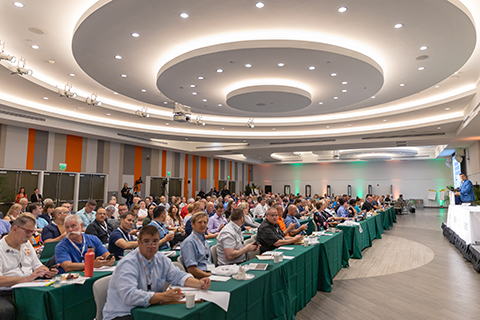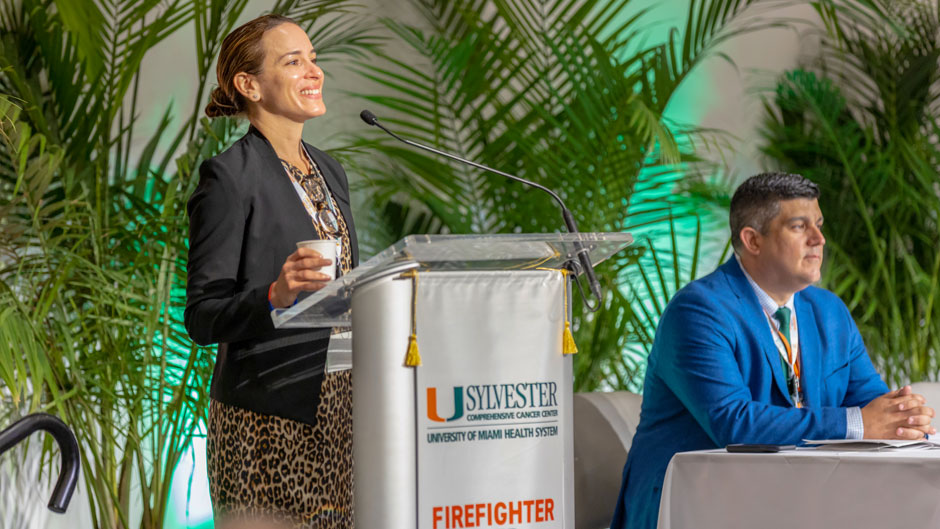The names etched on the National Fallen Firefighters Memorial in Colorado Springs underscore the grim truth about the leading cause of death among firefighters.
Over the past five years, 65 percent of the 944 firefighters whose names were added to the wall succumbed to job-related cancers.
This year will be no different, according to Patrick Morrison of the International Association of Fire Fighters. Of the 252 fallen firefighters who will be honored in Colorado this September, 201 died of occupation-related cancers, a reality that on Monday brought Morrison and more than 325 other firefighters, scientists, researchers, and other stakeholders from seven countries to the Shalala Student Center, where Sylvester Comprehensive Cancer Center hosted the inaugural State of the Science National Firefighter Cancer Symposium.
Their two-day mission at the University of Miami: to develop a scientific roadmap for controlling and preventing cancer in the nearly 350,000 career firefighters and more than 814,000 volunteers in the U.S. Fire Service.
“I haven’t seen the depth of this kind of science in one place,” said symposium co-chair Erin Kobetz, the director and principal investigator of Sylvester’s Firefighter Cancer Initiative, which is documenting the excess burden of cancer among Florida firefighters, and identifying methods for reducing the risks that, not long ago, were on the radars of few researchers or firefighters.
“If you has asked me four years ago when we started our work with the fire service I would never have anticipated that it would have culminated in a day like today, where we have leadership from across the globe, scientists and firefighters alike, here to help us think through the most challenging research questions about how we address the excess burden of cancer in the fire service,” said Kobetz, Sylvester’s associate director for population science and cancer disparity.
Symposium co-chair Alberto Caban-Martinez, assistant professor of public health sciences and deputy director of the Firefighter Cancer Initiative launched in 2015, expressed confidence that the collective knowledge and field expertise gathered for the first symposium of its kind will find answers.
“We are asking the bigger question of what is unknown, and what do we need to do in order to protect the men and woman who come to our rescue when we need it most,” he said. “What happens here in these next two days can indeed change firefighter health and safety.”

Over the past decade or so, multiple studies began showing that firefighters have higher rates of multiple cancers, including multiple myeloma, non-Hodgkin’s lymphoma, and prostate and testicular cancer, than the general population, and the reasons began to emerge: Every time firefighters respond to a fire, whether in a house, a dumpster, a car, or in wild lands, they can be exposed to an ever-increasing array of known cancer-causing agents and often bring the contaminants back to the station or home with them.
“Think about a simple dresser,” Caban-Martinez said. “Forty years ago it was probably built entirely from wood. Today it’s made of all these fancy things with all these plastics and synthetics. We think that’s part of the reason why we’re seeing higher rates.”
The other reason—the ingrained, tough-guy culture found in fire stations everywhere—brought Broward County Fire Rescue Lt. Lysander Rostow and Captain Alex Arreola, whose department recently lost two fellow firefighters to cancer, to the symposium. They came to learn the science that will help them convince their brethren to always wear their breathing masks and other safety equipment while fighting fires and to clean themselves, their truck, and their gear afterward, never storing it in their cabs, their sleeping quarters, or their homes.
“We are aggressively trying to change the culture of the fire service,” said Rostow, who like Arreola, is a member of his department’s joint occupational safety and health committee. “Wearing dirty gear was a badge of honor. It showed you were a tough guy and worked hard. You would never wash your gear because you wanted everyone to see how salty you were.”
Fortunately, said Nathan J. Trauernicht, the fire chief for the University of California, Davis, and one of the symposium keynote speakers, firefighters can no longer ignore the data and the data is changing the culture.
"It’s making people have an aha! moment,” Trauernicht said. “There’s this really great movement now, and it’s going to be propelled by events like this, where we say, ‘This is not smart.’ We’re not any less because we clean stuff.”
Another, more personal change, he said, is how he reacted when the fire chief he replaced at Davis recently died of cancer.
"Five years ago, I would have said, ‘Oh, Joe died of cancer. How sad,’’’ Trauernicht said. “But when I hear cancer and firefighter I no longer think of genetics or general risk factors. I think, ‘What happened over the course of his career? What were the exposures? And how do we quantify that so we can prevent it in the future?”

